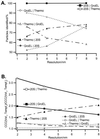Toward detecting and identifying macromolecules in a cellular context: template matching applied to electron tomograms
- PMID: 11087814
- PMCID: PMC18903
- DOI: 10.1073/pnas.230282097
Toward detecting and identifying macromolecules in a cellular context: template matching applied to electron tomograms
Abstract
Electron tomography is the only technique available that allows us to visualize the three-dimensional structure of unfixed and unstained cells currently with a resolution of 6-8 nm, but with the prospect to reach 2-4 nm. This raises the possibility of detecting and identifying specific macromolecular complexes within their cellular context by virtue of their structural signature. Templates derived from the high-resolution structure of the molecule under scrutiny are used to search the reconstructed volume. Here we outline and test a computationally feasible two-step procedure: In a first step, mean-curvature motion is used for segmentation, yielding subvolumes that contain with a high probability macromolecules in the expected size range. Subsequently, the particles contained in the subvolumes are identified by cross-correlation, using a set of three-dimensional templates. With simulated and real tomographic data we demonstrate that such an approach is feasible and we explore the detection limits. Even structurally similar particles, such as the thermosome, GroEL, and the 20S proteasome can be identified with high fidelity. This opens up exciting prospects for mapping the territorial distribution of macromolecules and for analyzing molecular interactions in situ.
Figures







References
-
- Hart R G. Science. 1968;159:1464–1467. - PubMed
-
- Koster A J, Grimm R, Typke D, Hegerl R, Stoschek A, Walz J, Baumeister W. J Struct Biol. 1997;120:276–308. - PubMed
-
- Baumeister W, Grimm R, Walz J. Trends Cell Biol. 1999;9:81–85. - PubMed
-
- Dubochet J, Adrian M, Chang J, Homo J C, Lepault J, McDowall A C, Schulz P. Q Rev Biophys. 1988;21:129–228. - PubMed
-
- Michel M, Hillmann T, Muller M. J Microsc (Oxford) 1991;163:3–18.
Publication types
MeSH terms
Substances
LinkOut - more resources
Full Text Sources
Other Literature Sources
Molecular Biology Databases
Research Materials

